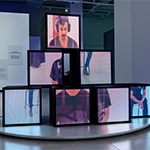Some of the world’s pre-eminent sound artists have joined forces for a major new exhibition in the United Arab Emirates. Curated by Dr Cathy Lane, Listening For Traces: Conflict, Sound & Memory is an experimental examination of the enduring impact of conflict on people, places, language, and relationships.
More than a dozen artists from USA, Europe, Africa, the Middle East and India have explored the sounds of the past and how they reverberate through time and into the present day in the landmark exhibition presented by Rizq Art Initiative (RAi) that takes place at Rizq Art Gallery in Abu Dhabi from 23 February 2024 to 20 March 2024. The artists’ diverse work reflects the cyclical nature of conflict, the wounds of history and the potent feedback loop that continues to exert influence on today’s world.
Four films are being screened at the exhibition, plus one LED video installation, a sound dome that holds five pure sound pieces, a sonic sculpture of speakers suspended from the ceiling and two text-based installations. “A wide range of sonic methodologies are found in the exhibition including silence or imagined sound; the use of archive materials and field recordings; musical performance; sound writing and spoken word,” says Dr Lane.
Artists participating in Listening For Traces: Conflict, Sound & Memory include Abdullah Al Othman (Saudi Arabia), Asma Ghanem (Palestine), Alexia Webster (South Africa), Christopher Marianetti (USA), Jananne Al Ani (UK/Iraq), Nour Sokhon (Lebanon), Open Group (Ukraine), Shirin Neshat (Iran), Uzma Falak (India), Yara Mekawei (Egypt) and four UK artists Louise K Wilson, Martin John Callanan, Thomas Gardner and Angus Carlyle.
Iranian artist Shirin Neshat presents her 1998 show Turbulent, a two-channel sound and video installation that tackles gender inequality in her home country. Jananne Al Ani’s Sounds of War II from 2023 looks at the effects of military operations on the British landscape, while Woomera/Nurrangar from Louise K Wilson is a 2007 multi-channel sound and video installation that takes us into remote Cold War sites in the South Australian desert. Elsewhere, Thomas Gardner investigates memory, trauma and reconciliation in his 2023 work Scored Out; Martin John Callanan catalogues conflicts from 1982 to the present in Wars During My Lifetime; while in Waves Finding the Shore, Angus Carlyle reflects on the last battle of World War II at Tokashiku Beach in Japan.
During the four-week exhibition a series of programmes and curatorial walkthroughs dive deeper into the relationship between conflict and its portrayal in sound art. On 23 February sound artist Safeya Alblooshi performed. Dr Lane will dissect the exhibition at Dubai’s Alserkal Foundation on 26 February, later in February renowned artist and Turner Prize winner Lawrence Abu Hamdan will speak about his works.
“The works in this exhibition are concerned less with the sound of conflict and more with the impact of sound in conflict and how that becomes inscribed on landscapes and bodies,” says Dr Lane. “Some of the artists have direct experience of conflict and their work is born from and reflects this. Others are more physically removed yet linked to the past through inherited trauma or strong connection to place. Several bear witness to wars and suffering that are little known or long forgotten. They poignantly attest to the scale and geographical extent of war in our lifetimes, powerfully conveying us the immediate and enduring effects of conflict on the body and the landscapes around us.”
Art Historian Shafeena Yusuf Ali is the Founder and Executive Director of RAi and believes sound art is a powerful and relevant medium. “Sound art seems to transcend the confines of the traditional canvas, requiring our immersion, commanding our active listening and most importantly transporting even the most unwilling participant to where the artist takes you,” she says. “In times of conflict, within the cacophony of chaos and the harmonies of hope, sound art finds a relevant place of expression. It prompts the listener to imagine, to empathise and to truly understand the nuanced layers of human conflict. Through the pieces in Listening for Traces we encounter the struggles that shape our present and the hopes that resonate towards our future. We hear the horror, the grief, the hope and the peace that the artists portray in their sound, but sometimes even louder in the silence between the sounds. May these sounds serve as both a witness and a healer.”
Listening For Traces: Conflict, Sound & Memory is presented in association with CRiSAP (Creative Research into Sound Arts Practice) a research centre within the University of the Arts in London, where Dr Lane is a professor of sound art. A hugely experienced artist, composer and academic, she has shown at a number of gallery installations and concert pieces and has written several books and essays about sound art.
Held on Reem Island in Abu Dhabi, the exhibition is hosted by RAi, an independent cultural institution that has become one of the UAE’s brightest new voices in the cultural landscape since opening in 2023. The College of Arts and Creative Enterprises at Zayed University in the UAE also helped to produce the exhibition.
Press release from Rizq Art Initiative
Image: Abdullah Al Othman. No Touch Torture. 2015. Image courtesy of Rizq Art Initiative



